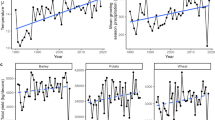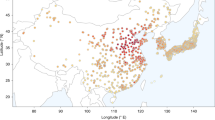Abstract
Changes in temperature and air pollution affect agricultural productivity, but most relevant research has focused on major annual crops (for example, wheat, maize, soy and rice). In contrast, relatively little is known about the effects of climate change and air quality on perennial crops such as fruits and nuts, which are important to dietary diversity and nutrition, and represent ~38% of California’s agriculture by economic value. Moreover, the adaptive capacity of perennial crops may be limited by their long lifespans and sometimes large establishment costs. Here, on the basis of statistical modelling of historical data and downscaled climate model projections, we jointly assess the impacts of climate and ozone levels on historical and future yields of perennial crops in California. Although the effects of warming to date are not statistically significant for many perennial crops, the yields of most perennials show a significant negative response to ambient ozone, ranging from −2% for strawberries to −22% for table grapes, implying total losses of roughly US$1 billion per year. This suggests that historical improvements in California’s air quality that reduced ozone exposures may have had large, unaccounted co-benefits for the state’s perennial crop yields, and further pollution reduction could create additional gains. Indeed, the co-location of regions with high production and high ozone damage indicates that opportunities to improve crop yields through pollution mitigation are large.
This is a preview of subscription content, access via your institution
Access options
Access Nature and 54 other Nature Portfolio journals
Get Nature+, our best-value online-access subscription
$29.99 / 30 days
cancel any time
Subscribe to this journal
Receive 12 digital issues and online access to articles
$119.00 per year
only $9.92 per issue
Buy this article
- Purchase on Springer Link
- Instant access to full article PDF
Prices may be subject to local taxes which are calculated during checkout



Similar content being viewed by others
Data availability
All historical data used are publicly available and open access, with the data sources listed in the Methods. The other data that support the findings of this study are available from the corresponding author upon reasonable request.
Code availability
The LASSO regression was conducted by using the lars 1.2 package in R, which is available at https://CRAN.R-project.org/package=lars.
References
Lobell, D. B. et al. Prioritizing climate change adaptation needs for food security in 2030. Science 319, 607–610 (2008).
Battisti, D. S. & Naylor, R. L. Historical warnings of future food insecurity with unprecedented seasonal heat. Science 323, 240–244 (2009).
Avnery, S., Mauzerall, D. L., Liu, J. F. & Horowitz, L. W. Global crop yield reductions due to surface ozone exposure: 1. Year 2000 crop production losses and economic damage. Atmos. Environ. 45, 2284–2296 (2011).
Avnery, S., Mauzerall, D. L., Liu, J. F. & Horowitz, L. W. Global crop yield reductions due to surface ozone exposure: 2. Year 2030 potential crop production losses and economic damage under two scenarios of O3 pollution. Atmos. Environ. 45, 2297–2309 (2011).
Myers, S. S. et al. Climate change and global food systems: potential impacts on food security and undernutrition. Annu. Rev. Publ. Health 38, 259–277 (2017).
Tai, A. P. K., Martin, M. V. & Heald, C. L. Threat to future global food security from climate change and ozone air pollution. Nat. Clim. Change 4, 817–821 (2014).
Burney, J. & Ramanathan, V. Recent climate and air pollution impacts on Indian agriculture. Proc. Natl Acad. Sci. USA 111, 16319–16324 (2014).
McGrath, J. M. et al. An analysis of ozone damage to historical maize and soybean yields in the United States. Proc. Natl Acad. Sci. USA 112, 14390–14395 (2015).
Lobell, D. B., Field, C. B., Cahill, K. N. & Bonfils, C. Impacts of future climate change on California perennial crop yields: model projections with climate and crop uncertainties. Agr. Forest Meteorol. 141, 208–218 (2006).
Lobell, D. B., Cahill, K. N. & Field, C. B. Historical effects of temperature and precipitation on California crop yields. Clim. Change 81, 187–203 (2007).
Lobell, D. B. & Field, C. B. California perennial crops in a changing climate. Clim. Change 109, 317–333 (2011).
Kerr, A., Dialesandro, J., Steenwerth, K., Lopez-Brody, N. & Elias, E. Vulnerability of California specialty crops to projected mid-century temperature changes. Clim. Change 148, 419–436 (2018).
Mills, G. et al. A synthesis of AOT40-based response functions and critical levels of ozone for agricultural and horticultural crops. Atmos. Environ. 41, 2630–2643 (2007).
Soja, G., Eid, M., Gangl, H. & Redl, H. Ozone sensitivity of grapevine (Vitis vinifera L.): evidence for a memory effect in a perennial crop plant? Phyton Ann. Rei Bot. A 37, 265–270 (1997).
Willett, W. C. Diet and health - what should we eat. Science 264, 532–537 (1994).
Kennedy, G., Ballard, T. & Dop, M. C. Guidelines for Measuring Household and Individual Dietary Diversity (Food and Agriculture Organization of the United Nations, 2011); http://www.fao.org/3/a-i1983e.pdf
Arimond, M. & Ruel, M. T. Dietary diversity is associated with child nutritional status: evidence from 11 demographic and health surveys. J. Nutr. 134, 2579–2585 (2004).
Sample Cost to Establish an Orchard and Produce Almonds (UCCE, UC-AIC, UC DAVIS-ARE, 2016); https://coststudyfiles.ucdavis.edu/uploads/cs_public/87/3c/873c1216-f21e-4e3e-8961-8ece2d647329/2016_almondsjv_south_final_10142016.pdf
Qin, Y. et al. Flexibility and intensity of global water use. Nat. Sustain. 2, 515–523 (2019).
California Agricultural Production Statistics (California Department of Food and Agriculture, 2018); https://www.cdfa.ca.gov/Statistics
California County Agricultural Commissioners’ reports (USDA-NASS, 2018); https://www.nass.usda.gov/Statistics_by_State/California/Publications/AgComm/index.php
California Agricultural Statistics Review (California Department of Food and Agriculture, 2018); https://www.cdfa.ca.gov/statistics/PDFs/2017-18AgReport.pdf
State of the Air 2019 (American Lung Association, 2019); https://www.lung.org/assets/documents/healthy-air/state-of-the-air/sota-2019-full.pdf
Mauzerall, D. L. & Wang, X. P. Protecting agricultural crops from the effects of tropospheric ozone exposure: reconciling science and standard setting in the United States, Europe, and Asia. Annu. Rev. Energy Env. 26, 237–268 (2001).
Lobell, D. B. & Asner, G. P. Climate and management contributions to recent trends in US agricultural yields. Science 299, 1032–1032 (2003).
Riahi, K. et al. RCP 8.5-A scenario of comparatively high greenhouse gas emissions. Clim. Change 109, 33–57 (2011).
Thomson, A. M. et al. RCP4.5: a pathway for stabilization of radiative forcing by 2100. Clim. Change 109, 77–94 (2011).
Young, P. J. et al. Pre-industrial to end 21st century projections of tropospheric ozone from the Atmospheric Chemistry and Climate Model Intercomparison Project (ACCMIP). Atmos. Chem. Phys. 13, 2063–2090 (2013).
Gao, Y., Fu, J. S., Drake, J. B., Lamarque, J. F. & Liu, Y. The impact of emission and climate change on ozone in the United States under representative concentration pathways (RCPs). Atmos. Chem. Phys. 13, 9607–9621 (2013).
Yahya, K., Campbell, P. & Zhang, Y. Decadal application of WRF/Chem for regional air quality and climate modeling over the US under the representative concentration pathways scenarios. Part 2: current vs. future simulations. Atmos. Environ. 152, 584–604 (2017).
Mueller, N. D. et al. Cooling of US Midwest summer temperature extremes from cropland intensification. Nat. Clim. Change 6, 317 (2016).
Bonfils, C. & Lobell, D. Empirical evidence for a recent slowdown in irrigation-induced cooling. Proc. Natl Acad. Sci. USA 104, 13582–13587 (2007).
Olszyk, D. M., Cabrera, H. & Thompson, C. R. California statewide assessment of the effects of ozone on crop productivity. JAPCA J. Air Waste Manag. 38, 928–931 (1988).
Air Quality System (US EPA, 2019); https://aqs.epa.gov/aqsweb/airdata/download_files.html
Technical Report on Ozone Exposure, Risk, and Impact Assessments for Vegetation (US EPA, 2007); https://www.epa.gov/fera/technical-report-ozone-exposure-risk-and-impact-assessments-vegetation
Cropland Data Layer (USDA-NASS, 2018); https://www.nass.usda.gov/Research_and_Science/Cropland/Release/index.php
Tibshirani, R. Regression shrinkage and selection via the Lasso. J. R. Stat. Soc. B 58, 267–288 (1996).
Efron, B. & Gong, G. A leisurely look at the bootstrap, the jackknife, and cross-validation. Am. Stat. 37, 36–48 (1983).
Yahya, K. et al. Decadal application of WRF/Chem for regional air quality and climate modeling over the US under the representative concentration pathways scenarios. Part 1: model evaluation and impact of downscaling. Atmos. Environ. 152, 562–583 (2017).
He, J. et al. Decadal simulation and comprehensive evaluation of CESM/CAM5.1 with advanced chemistry, aerosol microphysics, and aerosol–cloud interactions. J. Adv. Model. Earth Syst. 7, 110–141 (2015).
Glotfelty, T., He, J. & Zhang, Y. Impact of future climate policy scenarios on air quality and aerosol-cloud interactions using an advanced version of CESM/CAM5: Part I. model evaluation for the current decadal simulations. Atmos. Environ. 152, 222–239 (2017).
Glotfelty, T. & Zhang, Y. Impact of future climate policy scenarios on air quality and aerosol cloud interactions using an advanced version of CESM/CAM5: Part II. Future trend analysis and impacts of projected anthropogenic emissions. Atmos. Environ. 152, 531–552 (2017).
Bruyère, C. L., Done, J. M., Holland, G. J. & Fredrick, S. Bias corrections of global models for regional climate simulations of high-impact weather. Clim. Dyn. 43, 1847–1856 (2014).
Acknowledgements
C.H., Y.Q., A.A., J.A.B., F.C.M. and S.J.D. were supported by the US National Science Foundation (NSF) and the US Department of Agriculture (INFEWS grant EAR 1639318); D.T. was supported by NASA’s IDS programme (80NSSC17K0416). We acknowledge helpful discussions with D. B. Lobell. WRF/Chem outputs were generated under the US NSF EASM Program (AGS-1049200). WRF/Chem simulations were performed and processed under high-performance computing support from Yellowstone (ark:/85065/d7wd3xhc; https://www2.cisl.ucar.edu/supercomputer/yellowstone) provided by NCAR’s Computational and Information Systems Laboratory, sponsored by the NSF, and the national supercomputer TACC/NSF STAMPEDE2, provided as an Extreme Science and Engineering Discovery Environment digital service by the Texas Advanced Computing Center (http://www.tacc.utexas.edu), which is supported by NSF grant number aci-1053575.
Author information
Authors and Affiliations
Contributions
S.J.D., N.D.M. and C.H. designed the study. C.H. performed the analyses, with support from Y.Z. on datasets and S.J.D., N.D.M., J.A.B., A.A., F.C.M., Y.Q. and D.T. on analytical approaches. C.H. and S.J.D. led the writing with input from all co-authors.
Corresponding author
Ethics declarations
Competing interests
The authors declare no competing interests.
Additional information
Publisher’s note Springer Nature remains neutral with regard to jurisdictional claims in published maps and institutional affiliations.
Supplementary information
Supplementary Information
Supplementary notes, references, Figs. 1–15 and Tables 1 and 2.
Rights and permissions
About this article
Cite this article
Hong, C., Mueller, N.D., Burney, J.A. et al. Impacts of ozone and climate change on yields of perennial crops in California. Nat Food 1, 166–172 (2020). https://doi.org/10.1038/s43016-020-0043-8
Received:
Accepted:
Published:
Issue Date:
DOI: https://doi.org/10.1038/s43016-020-0043-8
This article is cited by
-
Air quality improvements can strengthen China’s food security
Nature Food (2024)
-
Transcriptomics, proteomics, and metabolomics interventions prompt crop improvement against metal(loid) toxicity
Plant Cell Reports (2024)
-
Pathways framework identifies wildfire impacts on agriculture
Nature Food (2023)
-
VOC species controlling O3 formation in ambient air and their sources in Kaifeng, China
Environmental Science and Pollution Research (2023)
-
Deterioration of extrafloral nectaries and leaf damages caused by air pollution in a Brazilian native species from the Atlantic Forest
Environmental Science and Pollution Research (2023)



